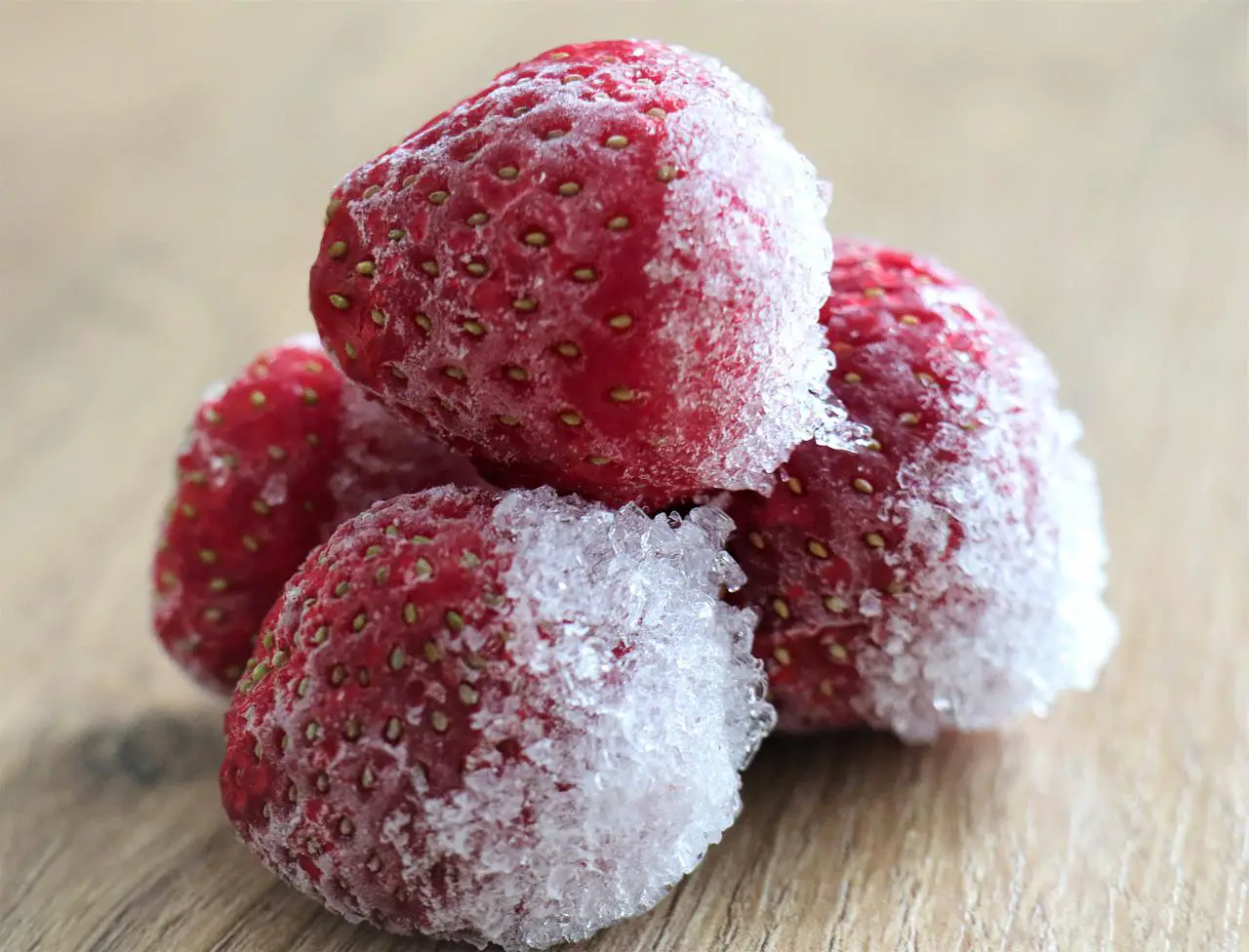If you want a tasty fruity snack, think about freezing whole strawberries in the freezer. They taste just as sweet as fresh and last for months. Even healthy popsicles made from frozen strawberries are possible; pack them tightly to prevent freezer burn. A bag of already-frozen strawberries is always a good choice for long-term use. However, you can still freeze them if you return from the market with too many cartons of berries!

When you freeze food properly, you’ll preserve most of its flavor and nutritional value while maintaining its quality. Strawberries are a straightforward, sweet, and bite-sized healthy food that will satiate your sweet taste. As a wonderful source of vitamin C, manganese, and folate, they are also excellent as a post-dinner dessert or breakfast to start the day. A fresh strawberry is delightful, but you know how quickly fruit goes bad if you’ve opened your fridge only to discover the delectable treat you were seeking coated in mold. These tricks will prolong the shelf life of your frozen strawberries, satisfy your sweet appetite, and reduce your fruit spending.
How to Freeze Strawberries?
Once you’ve decided to start freezing strawberries, you have a lot of alternatives. Planning how the frozen strawberries will be used before getting started is advisable, and how the berries are frozen will depend on their intended usage. Additionally, remember that frozen strawberries can be used instead of fresh ones in strawberry recipes. Just keep in mind that thawed whole strawberries will have a much softer feel than those picked berries.
Strawberries can be frozen whole, in slices or in puree form. When freezing huge strawberries, crushing or slicing the berries produces better results. Several techniques are described below. Freezing in a sugar or syrup pack improves the flavor and texture of the final product compared to freezing in unsweetened packs.
Freezing Whole Strawberries with a Syrup Pack
Making syrup before freezing strawberries in a syrup pack is necessary. An extremely thick syrup that contains 50% sugar is employed. To make it, combine four cups of sugar with four glasses of warm water. The mixture should be stirred until it becomes clear, after which it should be chilled before use. Clean, dry, and remove the caps from your strawberries to prepare them. Then, add the strawberries to the containers of your choice, being sure to leave enough room (see table above). Before sealing the containers, place a crumpled-up piece of wax paper or parchment paper on top of the strawberries to prevent them from floating above the syrup. After everything has been prepared, place the containers in the freezer to begin freezing and carefully close them.
Freezing Whole Strawberries with a Sugar Pack
Wash and remove the strawberry caps. Three-fourths of a cup of sugar should be added to each quart of prepared fruit, and the strawberries should be gently mixed in. Most of the sugar will melt (or you can let the strawberries sit for about fifteen minutes). Then, put the strawberries in the containers of your choice. Refer to the above table when putting them in jars to ensure you leave enough headspace for the jars you use. Place your containers’ lids firmly on top, then freeze your strawberries in the freezer.
Freezing Sliced/Crushed Strawberries
Wash the strawberries, take off the green crowns, and prepare any spoiled fruit. The strawberries can be cut or smashed (berries can be crushed partially or completely). Each quart of cut or crushed strawberries should have added three-fourths of a cup of sugar. Combine thoroughly. Place the finished berry/sugar mixture in the proper containers. Before freezing, seal the containers.
Freezing Strawberries Puree
Every method of freezing strawberries, including freezing strawberry puree, starts with fresh, spotless, decapped strawberries. Crush the strawberries and press them through a fine sieve after the preliminary preparation is finished. They can also be processed into a puree in a food processor or blender. Three-fourths of a cup of sugar can be added to each quart of strawberry puree; however, it is unnecessary. Before transferring the puree to your freezer containers, stir each quart until the sugar has completely dissolved. Once more, make sure your containers have enough room.
Some Ways to Freeze Strawberries
1. Select the Strawberries
It would help if you first got strawberries before you could begin freezing them. During the growing season, picking your strawberry farms are a great area to find a lot of fresh strawberries. Or, even better, you can cultivate strawberries in your backyard garden. Additionally, you may get them from grocery stores, supermarkets, and farmers’ markets.
2. Equipment Required for Freezing Strawberries
Gather the tools you’ll need before starting the freezing process for strawberries. You will also need a large bowl, a baking sheet with a lid or a shallow oven pan, a vacuum sealer, a colander or strainer, a knife or cap remover tool, and zip-lock freezer bags (a vacuum sealer works better if you have one accessible to you), and a freezer.
3. Drop the caps
Carefully remove the green, leafy crowns using your knife or strawberry decapping tool (also called hulls). Be sure to take only the green leafy portion and leave the entire red berry.
4. Wash and Sort Them
Then, add the strawberries to the large dish and cold water. Allow the floating strawberries to roll through your fingers after gently washing them. Strawberries that are rotting or mushy should be simple to identify. Take them out. Avoid letting the strawberries sit in the water to soak. Please continue to the next step as soon as they have been washed.
5. Colander Drain
All the pieces of leaves, lingering dust and dirt, and other debris should be removed after properly washing the berries in cold water. The strawberries should now be carefully poured into the colander or sieve to drain. Rinse the strawberries thoroughly in cool water. Allowing them to sit after rinsing will help eliminate as much excess water as possible.
6. Spread and Freeze
Spread the strawberries in the freezer to start freezing them after drained. The berries should be spread out in a single layer on your shallow pan or cookie sheet. Could you put them in the freezer after spreading? Strawberries take some time to freeze, so leave them in there until they are frozen. For frozen strawberries, it is better to leave them in for 16 to 24 hours.
7. Pack the Frozen Strawberries
Remove the strawberries from the freezer and place them in bags. If strawberries are contacting each other when freezing, they may need to be broken up. As soon as you’ve put them in the zip-lock bags, take out as much air as possible. Here, a vacuum seal system works great. You should completely seal the zip-lock bag if you don’t have a vacuum system. Just enough space should remain for a straw to be inserted. Using the straw, quickly shut the bag after sucking out as much air as possible. The bag has a label and a date. The frozen strawberries are packed and ready for storage in the deep freezer.
Tips
A few pointers are necessary if you want to freeze your strawberries successfully. If you pay close attention to these details, you can continue to enjoy your strawberries long after they have been picked.
- Ensure the cleanliness of your seals. Your seals may have air holes that degrade the quality of your seals and frozen food if they have crumbs or water on them.
- Ensure that your containers have enough headspace so that some expansion can take place during freezing without the containers being harmed. For assistance, go to the table above.
- Avoid keeping strawberries soaked in aluminum foil. In the presence of the acidic strawberry pack, wax or parchment paper works just as well and won’t dissolve as aluminum does.
- Use a permanent pen always to label your containers. Note the date of freezing, the fact that strawberries are in the container, and the kind of pack used.
- As soon as you can, freeze. The recommended storage temperature for strawberries is 0 degrees Fahrenheit (-18 degrees Celsius). Avoid stacking strawberry containers in the freezer, and only freeze up to three pounds of fresh strawberries per cubic foot of freezer space to hasten the freezing process. The strawberries should be frozen after a full day of freezing and can be piled at that point to maximize freezer space.
Before Freezing, Should Strawberries be Washed?
It is suggested but not required for organic strawberries. To remove any dirt before freezing, give the item a moderate wash in cold water. We strongly advise cleaning the berries thoroughly before freezing if they were cultivated traditionally.
One word of caution: do not wash your berries before freezing them if you intend to use them for wild yeast in beer or wine brewing. Any wild yeast will be eliminated as a result.
How can Strawberries be Frozen without Becoming Mushy?
Let’s face it; frozen strawberries will never defrost with the same feel as fresh strawberries, regardless of what you do. But if you adhere to a few straightforward guidelines, you can retain the strawberries in their proper shape and prevent mushiness:
- Avoid using overripe strawberries because they will become mushy when defrosted if they are dark red and extremely soft before freezing.
- Before transferring them to containers, freeze your strawberries on a baking sheet in a single layer. Large groups of frozen berries will defrost inequitably and become more likely to mush.
- Before freezing your strawberries, wash them, and this will eliminate any potential mold or bacteria that can hasten the decomposition of your strawberries.
Is Freezing Strawberries Whole or Sliced Better?
Although you can theoretically do either, it is a good idea to slice or at the very least cut the strawberries in half before freezing them, and this will make them simpler to handle when you are ready to use them. No matter what you do, make sure the green stems are cut off before freezing.
How Long will My Frozen Strawberries Last in the Freezer?
When kept in the refrigerator, fresh strawberries should be used within two to three days; however, if they are not vacuum-sealed, you should utilize them within 8 to 12 months. You may keep frozen strawberries for up to 2-3 years if you vacuum seals your berries.
Conclusion
During the chilly winter months, freezing strawberries can help you save money and provide a source of delectable fruit. Take advantage of your knowledge now that you understand how to freeze strawberries! Take the frozen strawberries out of the freezer and thaw them when ready to eat or utilize them. This can be accomplished in a few hours on the counter or throughout an entire night in the refrigerator. Sugar or syrup can be added to the strawberries during the freezing process to sweeten them. Happy eating and good times.

